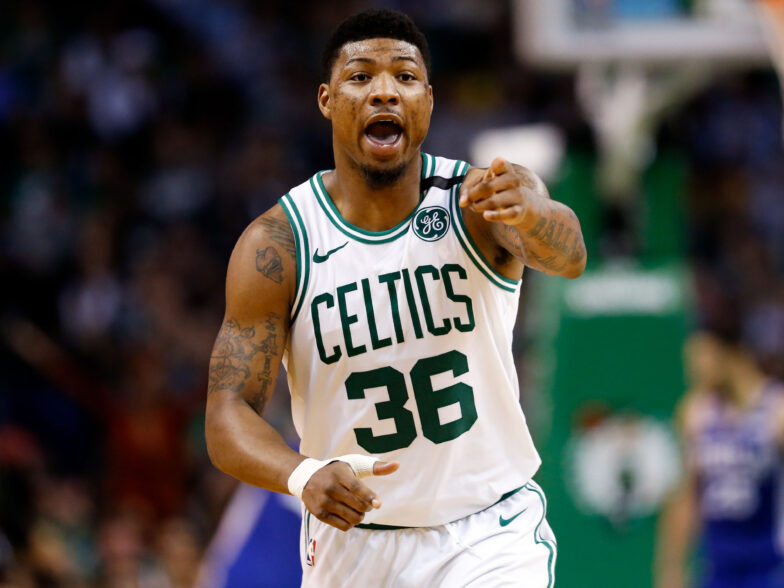The Rise of Intangibles in the NBA
Proving the Numbers Wrong
Greg M. Cooper-USA TODAY Sports
May 9, 2018; Boston, MA, USA; Boston Celtics guard Marcus Smart (36) reacts during the second half against the Philadelphia 76ers in game five of the second round of the 2018 NBA Playoffs at the TD Garden. Mandatory Credit: Greg M. Cooper-USA TODAY Sports
The value of numbers and statistical analysis within the NBA has greatly increased during recent years. As data manipulation has grown to utilize newer technology, statistics have evolved to not only capture made shots and defensive rebounds, but to measure player efficiency and offensive ratings. For the casual fan, numbers are a great way to learn more about the strengths and weaknesses of certain players or teams, and can even aid in sports betting. For basketball organizations and players, advanced data analytics can help to point out weaknesses in a player’s game so that more time and attention can be put into fixing these issues. However, the validity of numbers has been questioned by many students of the game as well. In reality, do numbers capture the whole picture?
In the past few years, advanced systems and player fits have gained prominence in the NBA. Coaches such as Mike D’Antoni and Steve Kerr have taken the league by storm with new philosophies of smaller lineups, getting a shot off in fewer than seven seconds, and positioning all five players behind the three point arc. Some form of statistical analysis, most commonly the inefficiency of mid range shooting, was the basis of these ideas.
The NBA Bubble allowed for some unique occurrences, calling into question the heavily statistical approach. Whether it was the Denver Nuggets starting a lineup with four big men, the impossible buzzer beater by Raptors forward OG Anunoby against the Celtics, or increased shooting efficiency due to a change in depth perception, the Bubble gave fans a distinctly different experience from a normal NBA playoff. The most prominent notion that arose in Orlando was the emergence of players whose game revolved around intangible aspects rather than high numbers in the box score. Nearly every team that made the second round, including the fifth-seeded Miami Heat who made it to the finals, had players with intangible qualities that proved critical to the team’s success. Intangibles are aspects of a player’s game that can’t be quantified with a stat or numerical analysis. The Bubble underscored the idea that numbers aren’t everything.
The greatest example of this might be Miami’s Jimmy Butler. The Heat shocked the world this year. After having a solid season and winning just over 60% of their regular season contests, Miami was seeded fifth in the weaker Eastern Conference for the playoffs. Their regular season performance was seen as a surprise to many, and much of the credit was given to the emergence of Bam Adebayo as an All-Star in his sophomore campaign. Miami continued to surprise the league by making it all the way to the finals, bypassing the likes of reigning MVP Giannis Antetokounmpo and his Milwaukee Bucks on their journey. The league and fans alike were stunned as nobody had predicted such success. The deciding factors were the intangible values of Jimmy Butler and his utilization by the league’s best coach, Erik Spoelstra.
Butler has a reputation for being controversial and seizing control. Incidents in which he has destroyed locker rooms, beaten the starters in a scrimmage using the third stringers, and called out the failures of his coaches were surprisingly common during Butler’s times in Minnesota and Philadelphia. However, what many people fail to see is that these tendencies may be Butler’s odd approaches to being a strong leader and demanding nothing but the best from his teammates. While Butler put up an impressive stat line in the playoffs, his numbers did not outshine those of his competitors. What Butler, and Miami as a whole, lacked in numerical values, they made up for with incredible coaching, as well as team play, hustle, gritty defense, and heart-all of which were a standard set by Butler. Spoelstra has often been criticized for letting the personalities of his players, such as LeBron James, take control of the coaching responsibilities. But others think that he strikes a perfect balance between coaching the team and defining tactics while also letting natural leaders unite the team and demand the best from everyone. Butler’s past incidents have gotten him kicked out of organizations due to coaches losing control as a result of his actions. Instead of limiting Butler’s influence, Spoelstra harnessed it and used it to positively impact the performances of the team.
Apart from providing leadership, Butler assumed a new role during the playoffs that contrasted his typical style of play. It proved to be crucial to the Heat’s success. Butler has been known throughout his career as a player whose offensive game centers around scoring the ball. This has earned him the nickname Jimmy Buckets. Within the Bubble, however, Spoelstra called for Butler to operate in a high pick and roll offense. Butler’s playmaking and facilitation allowed shooters like Duncan Robinson, finishers like Bam Adebayo, and scorers like Kendrick Nunn to see more involvement in the game. Butler certainly had no shortage of buckets himself. However, by having the ball start in his hands during almost every possession, Butler maximized the team output by doing what was best for the team and setting up whoever was in an ideal situation.
While coaches like Spoelstra utilize the intangibles of their players, there are certain examples in which the characteristics of a player make up for what a coach may lack. There is no better example of this than Marcus Smart of the Boston Celtics. Ever since the end of the Isaiah Thomas era in Boston, which also marked the departure of grinders such as Avery Bradley and Jae Crowder, the Celtics have played with significantly less heart. Boston has been, and continues to be, one of the most talented rosters in the entire NBA; however, they have continued to come up short, even losing to fifth-seeded Miami in this year’s playoffs, due to a lack of competitive nature within the team as a whole. One of the main contributors to this is coach Brad Stevens. Stevens is one of the smartest coaches in the league with regards to his systems, tactics, inbound plays, and defense. However, he is unable to push the team and unite his players, which can outweigh some of his positive attributes.
What separates Smart from other sixth men in the league is the necessity of his contributions. His competitive nature is more valuable to a team than the buckets of Lou Williams or Montrezl Harrell. The Celtics are far less effective when Smart is not on the floor, causing their potential output to drop. Players such as Jaylen Brown and Kemba Walker may not be able to lead a team themselves; however, they can and will match any intensity that is set. Jayson Tatum is immensely talented, but he does not have a fire burning within him; when he is the leader on the court, everyone else’s attitudes and spirits tend to drop. By having the cutthroat presence of Smart on the floor, the team’s general performance and desire to win rises. While Smart might not be the best player for the clutch or a buzzer beater, he is crucial to the performance of the Celtics in regular play.
It would also be a shame to overlook Smart’s defensive contributions. The Celtics are a good defensive team and have many strong defenders, such as Jayson Tatum, Jaylen Brown, and many others. However, the majority of Boston’s roster lacks grit and does not truly take pride in playing hard-nosed defense. Marcus Smart is the exception to this. Not only does he enjoy going toe to toe with the offensive superstars of opposing teams, but he also never backs down from a challenge when faced with physically huge competitors? Everyone on the team commits to their slides, closes out quicker, and boxes out stronger when Smart is calling the shots on defense.
Some players make a name for themselves by taking initiative and leading a team into battle. Others are vital to their organization because they are willing to do anything that is asked of them. Nobody demonstrates the latter better than PJ Tucker of the Houston Rockets. Tucker has traveled a winding road to make his name in the NBA. After struggling to find a spot early on and having to play in Europe to develop more as a player, PJ was able to capitalize on another chance in the NBA by fitting systems and fulfilling the needs of his coaches. For the most part, Tucker served as a role-playing wing whose responsibility was to shoot three pointers and play strong defense. In more recent seasons, Tucker’s willingness to accept new tasks has been tested by coach Mike D’Antoni.
While Tucker’s playstyle as a wing fits D’Antoni’s three point shooting philosophies, the departure of bigs such as Ryan Anderson, Clint Capela, and Nené led to the Rockets having a shortage of centers. Recognizing that Tucker has always been willing to do whatever the team needs, D’Antoni experimented with putting him at the center spot. Tucker’s 6’5” height is definitely a questionable attribute for any center. However, through his great attitude and tenacity, Tucker has still made it work and has wound up being an ideal center for D’Antoni’s small ball system and three or key mentality. While Tucker has wound up having to regularly guard players who are taller, stronger, and heavier than him, he has refused to back down from any of these opponents. Tucker’s tenacity has been beneficial for the Rockets because they have not needed to trade for a new big, especially when most bigs seem vastly out of place with D’Antoni’s playstyle.
Most intangible players cover a wide array of intangible aspects; however, some players such as Kyle Lowry specialize in one skill. While Lowry shares the hustle and leadership of the many other players analyzed thus far, he is also incredibly proficient in taking charges. Despite being relatively talented at getting steals, Lowry makes a great defensive contribution by being able to position himself to take charges. This is crucial to stopping slashers from being able to get to the basket, and, as demonstrated in the Raptors’ series against the Celtics in the Bubble, keeping teams on the perimeter and forcing them to settle for poor shots. Lowry’s defensive contributions fit well with the philosophies of coach Nick Nurse, who has been known to clog the paint against non-shooters such as Giannis Antetokounmpo, as well as keep a shot blocker such as Serge Ibaka waiting at the rim.
Having a team made up of some leaders, a competitor, and a charge taker will not be enough to win the NBA Championship. It is necessary to have immensely talented players who do well on the box score; however, it is also crucial to have players with phenomenal intangible values. Apart from Jimmy Butler, a prominent intangible player who can also put up fantastic numbers, most other highly intangible players are not the number one option on their team. Despite this, nearly every successful team has a noticeable contribution from an intangible player. Indeed, regardless of overall talent, teams that lack intangible players will struggle. Whether it be through the contributions of a veteran in the locker room, a highly experienced facilitator, or a sparkplug who will dive for every loose ball all 48 minutes of the game, it is crucial to address the areas of the game that the stats don’t cover. When making draft picks, free agency signings, and trades, organizations must consider more than a player’s stats in order to find the perfect fit.







